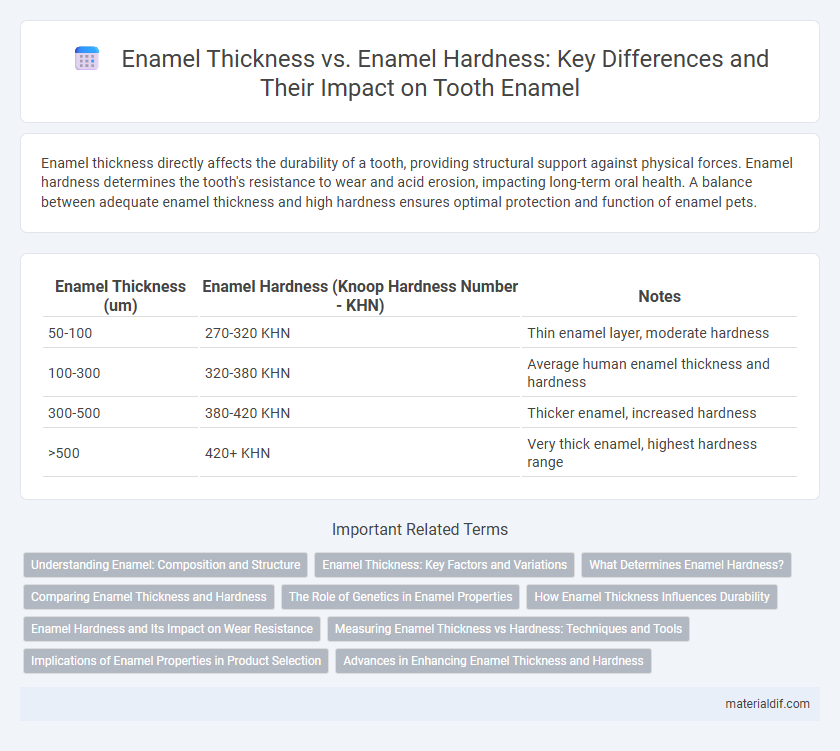Enamel thickness directly affects the durability of a tooth, providing structural support against physical forces. Enamel hardness determines the tooth's resistance to wear and acid erosion, impacting long-term oral health. A balance between adequate enamel thickness and high hardness ensures optimal protection and function of enamel pets.
Table of Comparison
| Enamel Thickness (um) | Enamel Hardness (Knoop Hardness Number - KHN) | Notes |
|---|---|---|
| 50-100 | 270-320 KHN | Thin enamel layer, moderate hardness |
| 100-300 | 320-380 KHN | Average human enamel thickness and hardness |
| 300-500 | 380-420 KHN | Thicker enamel, increased hardness |
| >500 | 420+ KHN | Very thick enamel, highest hardness range |
Understanding Enamel: Composition and Structure
Enamel thickness in human teeth typically ranges from 2.5 mm at the cusps to less than 0.5 mm near the cervical margin, directly influencing its protective efficacy. Enamel hardness, primarily determined by its high mineral content of hydroxyapatite crystals, averages around 3 to 5 GPa on the Vickers hardness scale, making it the hardest tissue in the human body. The interplay between enamel thickness and hardness is critical for withstanding occlusal forces and preventing dental wear and decay.
Enamel Thickness: Key Factors and Variations
Enamel thickness varies significantly across different teeth and individuals, typically ranging from 1.5 mm on molars to as thin as 0.5 mm near the cervical margins, influencing its protective function. This variation is crucial because thicker enamel generally offers enhanced resistance to mechanical wear and acid erosion, contributing to overall enamel hardness. Factors affecting enamel thickness include genetic predisposition, age-related changes, and environmental influences such as diet and oral hygiene practices.
What Determines Enamel Hardness?
Enamel hardness is primarily determined by its mineral content, specifically the concentration of hydroxyapatite crystals, which comprise about 96% of enamel by weight. Although enamel thickness contributes to the overall durability of a tooth, hardness is more directly influenced by the arrangement and density of these mineral crystals. Factors such as fluoride exposure and genetic variances also affect enamel hardness by altering mineral composition and crystal structure.
Comparing Enamel Thickness and Hardness
Enamel thickness varies significantly across different tooth surfaces, typically measuring between 1.5 to 2.5 millimeters, while enamel hardness is one of the highest among human tissues, rated around 5 on the Mohs scale. Thicker enamel generally provides greater resistance to wear and abrasion, but hardness is crucial for enamel's ability to withstand biting forces without fracturing. Comparing enamel thickness and hardness reveals that despite variations in thickness, consistent hardness levels are essential for maintaining overall enamel durability and protective function.
The Role of Genetics in Enamel Properties
Genetic factors significantly influence enamel thickness and hardness, determining its structural integrity and resistance to decay. Variations in genes such as AMELX, ENAM, and MMP20 regulate enamel matrix formation, affecting mineral density and hardness. Understanding genetic contributions aids in diagnosing enamel defects and developing targeted treatments for conditions like amelogenesis imperfecta.
How Enamel Thickness Influences Durability
Enamel thickness directly impacts its durability by providing a protective barrier that can better withstand daily wear and acid erosion, with thicker enamel reducing the risk of cavities and sensitivity. While enamel hardness contributes to resistance against abrasion, increased thickness offers enhanced shock absorption and structural support, making teeth more resilient to fractures. Clinical studies indicate that enamel thickness variations of 0.5 to 2.5 mm significantly affect overall tooth longevity and resistance to external stressors.
Enamel Hardness and Its Impact on Wear Resistance
Enamel hardness is a critical factor influencing wear resistance, as harder enamel resists abrasion and mechanical stresses more effectively than softer enamel. Variations in enamel thickness do not necessarily correlate with wear resistance; instead, the mineral content and microstructural organization primarily determine hardness. High enamel hardness, typically measured by the Knoop or Vickers hardness tests, enhances durability and longevity of teeth by minimizing surface degradation during mastication.
Measuring Enamel Thickness vs Hardness: Techniques and Tools
Measuring enamel thickness and hardness involves distinct techniques critical for dental analysis and treatment planning. Enamel thickness is commonly assessed using optical coherence tomography (OCT) and micro-computed tomography (micro-CT), offering precise, non-invasive imaging of enamel layers. Hardness evaluation typically employs microhardness testers, such as Vickers or Knoop hardness tests, providing quantitative data on enamel's resistance to indentation and wear.
Implications of Enamel Properties in Product Selection
Enamel thickness directly influences durability, as thicker enamel layers provide enhanced protection against wear and corrosion, while enamel hardness determines resistance to scratching and chipping. Selecting enamel with an optimal balance between thickness and hardness ensures longevity and aesthetic retention in cookware and industrial products. Understanding these properties aids manufacturers in tailoring enamel coatings to specific usage conditions, improving product performance and customer satisfaction.
Advances in Enhancing Enamel Thickness and Hardness
Recent advances in biomimetic materials have significantly improved enamel thickness and hardness by promoting the remineralization process at a nanostructural level. Innovations in fluoride-based treatments and calcium phosphate compounds enhance the enamel's resistance to acid erosion, resulting in thicker, more durable enamel layers. These developments in dental technology contribute to prolonged tooth vitality and reduced sensitivity through targeted reinforcement of enamel microstructure.
enamel thickness vs enamel hardness Infographic

 materialdif.com
materialdif.com